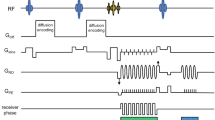Summary
With the development of fast spin echo (FSE) MRI techniques, T2-weighted images of the brain may be obtained much more quickly than when using conventional spin echo techniques (CSE), because made the individual echoes on the FSE pulse sequence are phase encoded, allowing acquisition of the same spatial information as in CSE with less excitations. The pulse sequence parameters (echo train length, bandwidth echo spacing) are discussed. Images were obtained on four volunteers using both CSE and FSE while varying repetition time, echo time and matrix. Comparison for signal intensity gray-white differentiation, fat and CSE signal, arifacts and vascular resolution showed that FSE images comparable in quality to those of CSE can be obtained in less than half the time. A practical choice of FSE parameters is recommended for clinical use. However, artifacts, possibly related to CSF and vascular pulsation, of which the radiologist should be aware, were identified on the FSE images.
Similar content being viewed by others
References
Hennig J, Naureth A, Friedburg H (1986) RARE imaging: a fast imaging method for clinical MR. Magn Reson Med 3: 823–833
Hennig J, Friedburg H (1988) Clinical applications and methodological developments of the RARE technique. Magn Reson Imaging 6: 391–395
Melki PS, et al (1991) Comparing the FAISE method with conventional dual-echo sequences. J Magn Reson Imaging 1: 319–326
Mulkern RV, et al (1990) Contrast manipulation and artifact assessment of 2D and 3D RARE sequences. Magn Reson Imaging 8: 557–566
Twieg DB (1983) The k-trajectory formulation of the NMR imaging process with applications in analysis and synthesis of imaging methods. Med Phys 10: 610–621
Author information
Authors and Affiliations
Rights and permissions
About this article
Cite this article
Tien, R.D., Felsberg, G.J. & MacFall, J. Practical choices of fast spin echo pulse sequence parameters: clinically useful proton density and T2-weighted contrasts. Neuroradiology 35, 38–41 (1992). https://doi.org/10.1007/BF00588276
Received:
Issue Date:
DOI: https://doi.org/10.1007/BF00588276



